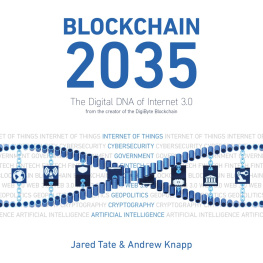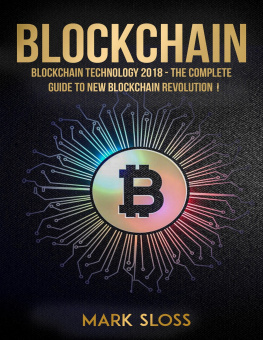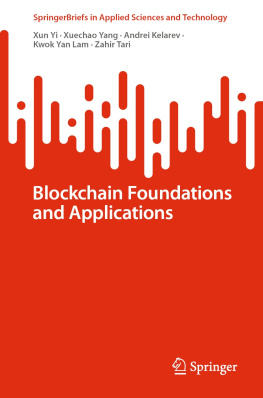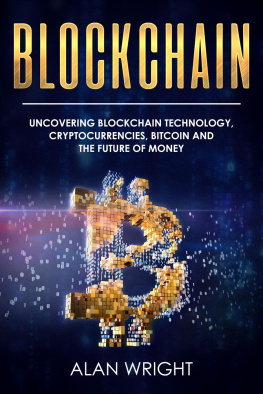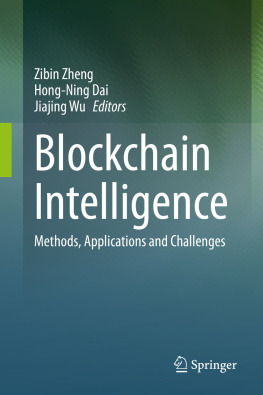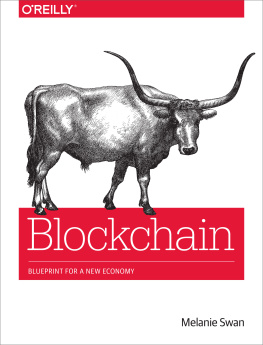Tate Jared - Blockchain 2035 eBook
Here you can read online Tate Jared - Blockchain 2035 eBook full text of the book (entire story) in english for free. Download pdf and epub, get meaning, cover and reviews about this ebook. publisher: BlueShed LLC, genre: Politics. Description of the work, (preface) as well as reviews are available. Best literature library LitArk.com created for fans of good reading and offers a wide selection of genres:
Romance novel
Science fiction
Adventure
Detective
Science
History
Home and family
Prose
Art
Politics
Computer
Non-fiction
Religion
Business
Children
Humor
Choose a favorite category and find really read worthwhile books. Enjoy immersion in the world of imagination, feel the emotions of the characters or learn something new for yourself, make an fascinating discovery.
- Book:Blockchain 2035 eBook
- Author:
- Publisher:BlueShed LLC
- Genre:
- Rating:5 / 5
- Favourites:Add to favourites
- Your mark:
- 100
- 1
- 2
- 3
- 4
- 5
Blockchain 2035 eBook: summary, description and annotation
We offer to read an annotation, description, summary or preface (depends on what the author of the book "Blockchain 2035 eBook" wrote himself). If you haven't found the necessary information about the book — write in the comments, we will try to find it.
Blockchain 2035 eBook — read online for free the complete book (whole text) full work
Below is the text of the book, divided by pages. System saving the place of the last page read, allows you to conveniently read the book "Blockchain 2035 eBook" online for free, without having to search again every time where you left off. Put a bookmark, and you can go to the page where you finished reading at any time.
Font size:
Interval:
Bookmark:
Blockchain 2035
The Digital DNA of Internet 3.0
By
Jared Tate
Founder of the DigiByte Blockchain
Andrew Knapp
Founder and CEO of VESTi Inc.
Published by BlueShed LLC, A Blockchain Innovation Company.
Copyright 2019 Jared Tate & Andrew Knapp, all rights reserved.
ISBN 978-0-578-47450-2
Published, October 28th 2019.
Cover art by Gandr&Kich
This book is dedicated to all the past, present, and future blockchain innovators and the entrepreneurs who will make ideas presented in this book (and more) a reality.
Table of Contents
The blockchain stands to be among the most fundamental technological, sociological, and political innovations of the current era. It represents the next stage in the evolution of the internet that our world has come to so heavily rely upon, for everything from providing news and entertainment to streamlining logistics and finance. The existing internet has flattened the world, making information widely available and scalable in the same manner that Gutenbergs printing press made books cheaper and more available half a millennium ago.
Instead of working out of a dusty workshop in Mainz, the internet is a collective mass of cables, server farms, and billions of devices, all of which can effectively exchange and store information. This is not without its drawbacks - a significant second-order effect of this system is that the smooth transmission and consolidation of information has also led to massive data breaches and insecurity, endless copying of data that should have been kept private, and enormous hierarchies dominated by a few companies who have mastered the game in the markets that they dominate.
By 2035, blockchain will be more ubiquitous than quantum computing, as broadly used as the Internet of Things, and will reach maturity before any general AI does. The next evolution of the internet is now possible with the introduction of the blockchain.
For the very first time, we can recreate the uniqueness, decentralization, security, and continuity of critical data in a way that mirrors the way biological and physical nature preserves and procreate life across all species. Rather than the endless duplication of information technology, the blockchain emulates how nature has been storing and transmitting information for over a billion years. Further, it follows the same physical laws that inspired countless advances in human technology in the past and enriches our means for systems to interact with each other.
Portable mechanical clocks improved our ability to navigate the globe by allowing sailors to judge longitude. The introduction of marine chronometers allowed users to judge their distance from a standard time (GMT), and thus measure how far they were from that based on a standardized understanding of the earths rotation. To continue the analogy, this was possible because there was a new ontology - a new system of categories and rules - that sailors could readily use for a specific purpose.
Not only is tying a linear representation of time to the internet possible with blockchain it is now possible to tie that linear progression to validate the existence of unique digital entities across several disciplines. Our ancestors won out over other competing species by their ability to adapt . Humans embody decentralization and diversity while retaining and communicating what we have learned to the next generation. This decentralization has enabled us to preserve valuable characteristics and information while adapting to the myriad of challenges we have encountered in our environment and history.
Human technology resembles biology in that the most robust systems have generally tended to overshadow weaker and less developed ones. Historically, the same rule went for culture, and the groups who best used and deployed new ideas gained the upper hand over those that did not. Technologies are an extension of this competitive biological process. Were confident that the most reliable and most decentralized blockchains will eventually win out , as they best embody these natural laws. A s the technology finds its feet in the marketplace, those prepared to strike the balance between innovation and decentralization will be the biggest winners.
Just like powerful families, even within the strongest blockchains those chains are constantly forking, developing, iterating, and adapting, in ways that better enable them to provide value and survive in a competitive world. Today, blockchain technology is going through its adolescence, a time in which it is being evaluated and establishing just where it fits in the larger world.
The next stage, which will happen between the time were writing this book and the year 2035, will not be without trials and tribulations. In most new industries, often, the first pioneers and innovators are overshadowed by upstart competitors and underdogs who answer the clunky innovations of those before them with a catchier product, a more robust business model, and viral growth. This progress will happen in the blockchain space, and many of the existing titans as we write this will be overcome by platforms that find more ideal use cases for the technology.
It took the internet 60 years to develop, and 30 of those years were spent to find its commercial roots and become the extension of human civilization that it is today. It is fitting to infer that we will look back on the year 2020 from 2035 in the same way that we now look back on 2004 from 2019 - before smartphones, YouTube, and Facebook changed our lives.
This timeframe is the origin of our title: Blockchain 2035, and our purpose in this book is to provide a helpful forecast for the pathways that this new technology might take as it comes into maturity.
Imagine for a moment the DNA resting in every cell nucleus of your own body. That DNA embodies all the code that makes you, you. We have billions of strands of DNA, composed of just 20 amino acids, strung in patterns not unlike words in every cell in our living bodies. These patterns detail every element of our physical embodiment, from our skin tone to the quality of our bones. Better yet, everything we eat has DNA - were all part of a macro-organism that is bigger than us and helps us sustain our advanced brains by providing energy and building materials similar to our own bodies.
DNA is the decentralized blueprint that largely determines who you are and how you fit into the larger world as a biological organism, including some of the essential elements of our personalities and intellects. From DNA, your body has the necessary information to recreate not just organs but whole people through procreation.
To borrow from a claim cited early on in Max Tegmarks seminal recent book, Life 3.0: Being Human in the Age of Artificial Intelligence, our DNA represents the critical blueprint for creating and supporting a much more complex system, which is that of our conscious brains. Tegmark cites analysis that estimates the total information encoded in a given cells DNA is roughly 1.6 gigabytes, which is an amazingly small number for how complex we are as organisms and how elaborate our minds are even in childhood.
By comparison, the same source estimates that the neural connections in our brains - which store all our memories, skills, habits, and impulses - store a whopping 100 terabytes. That 100TB of data represents our capacity for inherited knowledge and systems, which is a cornerstone of Tegmarks title.
In Life 1.0, bacteria existed as simple machines that follow predictable instincts that are hard-coded by their DNA.
In Life 2.0 (humans, to lesser degree primates and dolphins), this genetic code allows the ability to pass cognitive information down through use of symbols and language, in addition to the gifts of raw instinct.
Next pageFont size:
Interval:
Bookmark:
Similar books «Blockchain 2035 eBook»
Look at similar books to Blockchain 2035 eBook. We have selected literature similar in name and meaning in the hope of providing readers with more options to find new, interesting, not yet read works.
Discussion, reviews of the book Blockchain 2035 eBook and just readers' own opinions. Leave your comments, write what you think about the work, its meaning or the main characters. Specify what exactly you liked and what you didn't like, and why you think so.

